Samsung Galaxy Note II N7100 review
Not everyone knew what to do with a device with a screen size that was midway between a mobile phone and a tablet.
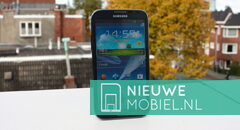
Nevertheless, 10 million of them have been sold worldwide and this category of devices has been given its own name; the phablet. Recently the Samsung Galaxy Note II was released and we have been able to try this improved version.
We started our revision period of the Galaxy Note II with an over-the-air update of the firmware. This is always pleasant because it often brings speed improvements or new functions. Moreover, the Note II already has a 5.5 inch screen, 8 megapixel camera and 1.6 GHz quadcore processor.
Identifying competition for the Note II is difficult because it is such a special device with few natural enemies. LG has the Optimus Vu and the newer Vu II but both are not available here. Devices with a slightly smaller screen include the Samsung Galaxy S3, HTC One X+ and the Nokia Lumia 920. The new iPhone 5 can't be completely ignored either.
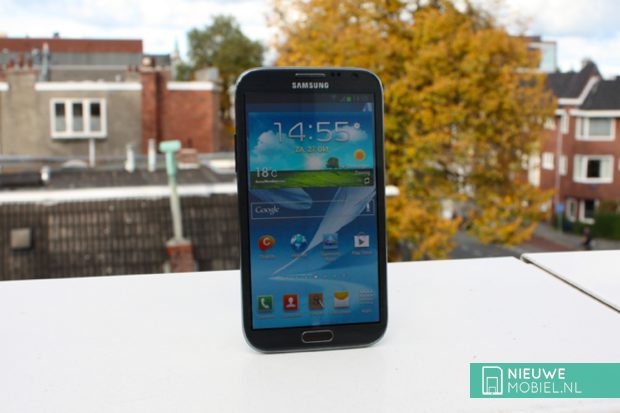
What's with the device?
Although phones are getting bigger and bigger, the packaging should be as small as possible. Once again Samsung has succeeded in this. The Note II only just fits in the box. We also found room for an in-ear headset with sleaves in different sizes, a USB cable and an adapter plug for the socket. Everything is in white and looks neat. The USB cable is on the short side and the plug is very loose in the device. Although there is room for a microSD card in the unit, it is not included.
Appearance
Compared to its predecessor, the Note II hasn't radically changed in appearance, but due to the refinement in details it does look considerably better. Moreover, it is very similar to the 'Nature' inspired Galaxy S3. Because the screen is still slightly larger than its predecessor but its dimensions are not proportional, there is even less empty space left around the screen. This means that the touch-sensitive buttons under the screen are even closer to the screen and you touch them just a little faster by accident.
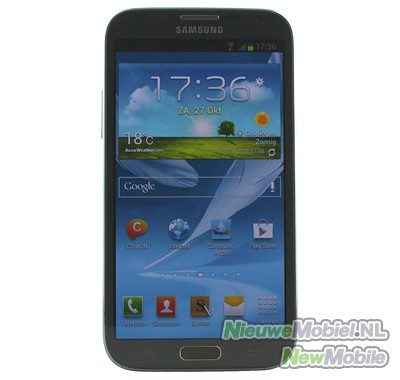

There's still a shiny edge around it. The battery cover is no longer made of dark grey matt plastic but shiny plastic with a brushed aluminium look. This makes for a nicely healed but reduces the grip you have on the device. Apart from two small cut-outs for the camera and flash, the battery cover is also completely smooth and covers the entire back of the camera.
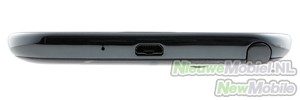
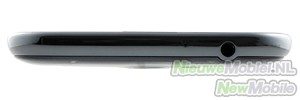
".
The bottom of the unit is for USB connection. In addition, the S-pin or stylus disappears almost seamlessly into the device. On the left side of the unit are the volume buttons and on the right side the power button.
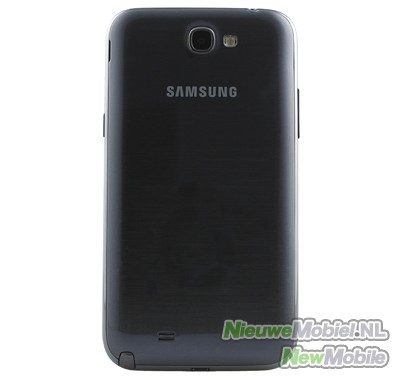

Despite being reasonably heavy, it is less than an inch thick. Because of this, it doesn't have a very clumsy appearance and is quite manageable. However, it will not fit in every pocket or slip out quickly when you sit down.
Endurance
A screen as large as the Note II requires quite a bit of battery power and irreversibly affects endurance. They must have realized that with Samsung and because the screen is 1.5 times as big as normal, they have put in a battery that is almost twice as big as normal. Namely one of 3100 mAh.
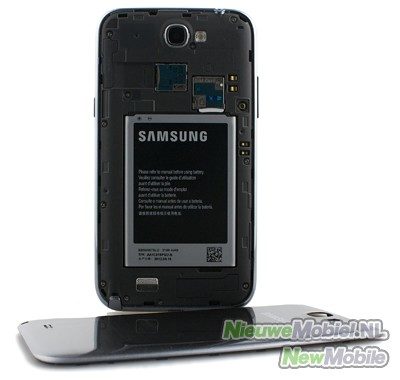
Despite the fact that the device is not restrained in its energy consumption, it is quite easy to let it last for 1.5 days on one battery charge during normal use. In addition, Samsung offers you a few more battery saving options.
".
Call quality
Because the Note II is almost as big as a regular home phone, the microphone is always close to your mouth when calling. So our conversation partners had nothing to complain about the sound quality. The ear loudspeaker can be very loud, but at the highest volume level it quickly gives a bit of distortion. The speaker on the back of the device can also be very loud and gives an amazingly good sound quality, even at the highest volume level.
".
Display
The display is not unimportant for a fulltouch smartphone anyway, but in the case of the Note II, it's worth twice as much to take a closer look. Diagonally, the screen measures 5.5 inches and has a resolution of 1280 x 720 pixels. Slightly fewer pixels than its predecessor, but hardly noticeable to the naked eye.
Despite the size of the screen, hardly any more information or interface is visible on it than on Android devices with a smaller screen. Everything is simply displayed larger. This is sometimes useful, but we would like to be able to place extra icons or widgets on the home screens, for example. By the way, you can make the font smaller, but also larger.
".
A complaint often heard in the past about Super AMOLED screens is that they display colours far too bright and unrealistic. Samsung has thought of this by giving you the possibility to choose from different screen modes. One can choose from: dynamic, standard, natural or film. Another problem with Super AMOLED is that white is not really white on the screen because there is a blue-green haze over it. This is also a problem with Note II. Only if you set the screen brightness to 100%, this seems to disappear.
".
A nice new feature that Samsung adds to its devices is 'Smart Slides'. The camera at the front detects whether you are looking at the screen, and as long as that is the case, snooze mode will not be switched on. It does not work flawlessly yet, but it is a nice addition. Especially on a device with such a large screen as the Note II on which you can easily read a long piece of text.
Menu
As mentioned before, we started testing Note II by updating the firmware. The device was already equipped with Android 4.1 Jelly Bean, the latest version, and the Touchwiz interface, but Samsung found it necessary to add some extra features.
".
But let's start with the lock screen. Five user-selectable shortcuts to apps can be placed on it. The device is unlocked by haphazardly swiping across the screen.
".
The possibilities of the start screens may now speak for themselves. A maximum of seven are available and thanks to Jelly Bean, the format of widgets can now also be changed. The functionality hidden behind the notification bar does deserve extra attention. Samsung has added some more to the Note II and Jelly Bean has also expanded the possibilities.
".
The most important addition to the firmware update is the ability to multitask split screen in two different apps. To activate this, simply press and hold the back button and a dock will appear on the left side of the screen. The apps listed here are the only ones available for this feature. Dragging an app off the dock opens it.
".
Partly due to numerous lawsuits and complaints from Apple, Samsung has had to adjust its 'shell' about Android and frankly this is only positive as far as we are concerned. Because Android looks better and better by default, changes made by manufacturers need to be less drastic. The widgets that Samsung itself adds are still a bit disappointing. They generally look rude and childish.
Phonebook
The contact application on the Note II is largely the same as the standard application in Android but has been given a Samsung sauce. Contacts can be found via the contact list or via the phone app. Using smartdial, a specific contact can be found quickly in the phone application and for more information you can go to the contact list.
".
At first glance, the contact list is nothing more than that. But when you swipe from left to right over a name, this person will be called immediately. A swipe the other way will open the SMS screen. When linking different data from one and the same contact, Samsung still falls short. It is possible, but then you will have to do most of it manually. Samsung also has a list where you can put blocked contacts.
Messaging
In addition to the excellent standard Gmail app, Samsung's own app is also available for mail. It can handle almost any type of mail account and multiple accounts can be synchronized with it. Messages from these accounts can also be displayed together in one screen. When the device is held horizontally, this app can work in split screen.
".
Samsung nowadays installs ChatON on its devices by default. This is a copy of Whatsapp but has far fewer users.
".
Typing with the device in the vertical position is very easy and fast. Especially with two hands. The QWERTY keyboard is spacious enough and above the letters there is an extra row for numbers. The spell checker also works very well.
".
Because Samsung also understands that users often want to type with one hand on their phone and the screen of the Note II is too big for that, they have added an extra option for one-handed operation. This means that the QWERTY and numeric keypad are reduced in size and placed on the right or left side of the screen.
Connectivity
In addition to the standard and now generally known connection options, Note II also features LTE and NFC. These are respectively a new fast mobile Internet technology and a way to exchange data wirelessly. Unfortunately, for the time being, the applicability of both is still very limited in practice. With S Beam, you can exchange files wirelessly with other devices that also support this. So in practice other Samsung phones.
".
Despite the fact that Chrome is now available for Android, Samsung has chosen to use the standard browser and expand it itself. The functionality of this is largely similar to Chrome. Samsung did add a number of buttons in the address bar. Additional functions can be used via the menu. The browser is nice and fast, and thanks to the large screen, desktop pages can also be used very well.
".
Scrolls sometimes show some hiccups. Pages are not re-scaled by default after zooming. This is a function you have to turn on yourself deep in the settings menu. On the latest Android devices there is no support for Flash anymore.
Camera
The camera on the back of the Note II is an 8-megapixel one with a single LED flash. Although the interface may not be very convenient, it works well and the most important functions are within reach. The camera starts very quickly and especially the HDR-function works quite well.
".
In the search window, the flash, photo mode and effects can be adjusted. For more extensive options, turn to the settings menu and set continuous shooting, scene mode, exposure, focus, timer, resolution, white balance, ISO, metering, outdoor visibility, auto contrast, auto sharing, anti-vibration, GPS tag and image quality.
".
The quality of the photos is very good in good light conditions and in dark environments you will also get a lot with the very bright flash. Details are clearly visible and the amount of noise is minimal. Colors may be a bit too bright but it is certainly not annoying.
The video camera can record with a maximum resolution of 1920 x 1080 pixels. The available settings are flash, video mode, effects, exposure, timer, resolution, white balance, outdoor visibility, guidelines, anti-vibration, GPS tag and quality.

Existing programs
The following apps are standard on Note II: Allshare play, calculator, ChatON, dropbox, email, fm radio, Game hub, voice search, clock, my files, mp3 player, paper artist, readers hub, S note, S planner, S suggest, S voice, Samsung apps, Samsung GO, voice recorder, talk and video player.
".
The list of standard programs on Note II is not exaggeratedly long, but despite this there are still a number of unnecessary apps in between. Manufacturers do not succeed in eliminating this completely. It is a way for them to give their own twist to an operating system on which they have less and less influence. Game hub, Readers hub, S suggest and Samsung apps all have more or less the same function as the Google Play Store.
Games
There are no games installed on the Note II. You could download them from the Game Hub, but it does not register previous purchases from the Play Store, so the user-friendliness leaves something to be desired.
Extras
Although Samsung has done its best to integrate the functions of the S Pen as much as possible into the standard applications of the Note II, we would like to treat it separately as it is its most distinctive feature next to the large screen. Moreover, Samsung has expanded the functionality compared to the first Note. The stylus is slightly longer and thicker, which makes it easier to handle.
".
When the S Pen is pulled out of the device, it automatically opens an additional home screen containing the S Note widget and a number of specific apps. Almost the entire interface can then be controlled with the stylus, although sometimes it does not respond accurately or a finger has to be used, which is annoying. In some applications, hovering the S Pen about an inch above the screen can activate a specific action or preview of content. This may not be something you will quickly discover without consulting the manual.
".
The most obvious function is, of course, to enter text using the S Pen. It takes a bit of dexterity and the software sometimes had a lot of trouble with our handwriting. Therefore, taking class notes or minutes is not something we would choose Note II for. However, it is suitable for shorter notes or drawings and cutting and pasting images from other media works well after some study and practice.
Conclusion
though at Samsung they may not know it yet or may not want to know it, the Galaxy Note II is actually the perfect smartphone for seniors.
The beautiful and large screen is an obvious plus to choose for the Note II, but whether the related size of the device can continue to charm you is a point of doubt for us. In one application, the size of the screen can be a disadvantage, while in others it is perfectly suited. The standard applications of a mobile phone work fine and on top of that come the relatively long battery life, the good camera and fast processor.
To get all the functionality out of the S Pen, you really need to sit down for a while and put study time and practice in it, because you can't get there with just a little playing and tinkering. This is the reason why this accessory did not convince us that this is the reason for the average user to purchase the Note II.
















































